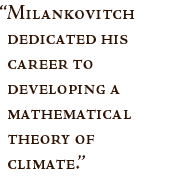
 |
||
|
|
||
 The Serbian astrophysicist Milutin Milankovitch is best known for
developing one of the most significant theories relating Earth motions
and long-term climate change. Born in 1879 in the rural village of Dalj (then part of the Austro-Hungarian Empire, today located in Croatia), Milankovitch attended the Vienna Institute of Technology and
graduated in 1904 with a doctorate in technical sciences. After a brief
stint as the chief engineer for a construction company, he accepted a
faculty position in applied mathematics at the University of Belgrade in
1909—a position he held for the remainder of his life.
The Serbian astrophysicist Milutin Milankovitch is best known for
developing one of the most significant theories relating Earth motions
and long-term climate change. Born in 1879 in the rural village of Dalj (then part of the Austro-Hungarian Empire, today located in Croatia), Milankovitch attended the Vienna Institute of Technology and
graduated in 1904 with a doctorate in technical sciences. After a brief
stint as the chief engineer for a construction company, he accepted a
faculty position in applied mathematics at the University of Belgrade in
1909—a position he held for the remainder of his life.
Milankovitch dedicated his career to developing a mathematical theory of climate based on the seasonal and latitudinal variations of solar radiation received by the Earth. Now known as the Milankovitch Theory, it states that as the Earth travels through space around the sun, cyclical variations in three elements of Earth-sun geometry combine to produce variations in the amount of solar energy that reaches Earth:
Together, the periods of these orbital motions have become known as Milankovitch cycles. next: Orbital Variations |
 On the Shoulders of Giants
Images
| ||
Orbital Variations
Obliquity (change in axial tilt)
|
 On the Shoulders of Giants
Left: The eccentricity of the Earth's orbit changes slowly over time from nearly zero
to 0.07. As the orbit gets more eccentric (oval) the difference between the distance
from the Sun to the Earth at perihelion (closest approach) and aphelion (furthest
away) becomes greater and greater. Note that the Sun is not at the center of the
Earth's orbital ellipse, rather it is
at one of focal points.
Note: The eccentricty of the orbit shown in the lower image is a highly
exaggerated 0.5. Even the maximum eccentricity of the Earth's orbit—0.07—it would
be impossible to show at the resolution of a web page. Even so, at the current eccentricity
of .017, the Earth is 5 million kilometers closer to Sun at perihelion than at aphelion. (Images
by Robert Simmon, NASA GSFC) | ||
Precession
|
Left: The change in the tilt of the Earth's axis (obliquity) effects the magnitude of seasonal change. At higher tilts the seasons are more extreme, and at lower tilts they are milder. The current axial tilt is 23.5°. Image by Robert Simmon, NASA GSFC) | ||

next: Milankovitch Theory
|
Left: Precession—the change in orientation of the Earth's rotational axis [this can be seen more clearly in an animation (small (290 kB QuickTime) or large (1.2 MB QuickTime))]—alters the orientation of the Earth with respect to perihelion and aphelion. If a hemisphere is pointed towards the sun at perihelion, that hemisphere will be pointing away at aphelion, and the difference in seasons will be more extreme. This seasonal effect is reversed for the opposite hemisphere. Currently, northern summer occurs near aphelion. (Image by Robert Simmon, NASA GSFC) | ||
|
On the Shoulders of Giants
Left: Over thousands of years the orientation of the Earth's rotational axis changes, like that of a spinning top as it slows down. (Animation by Robert Simmon, NASA GSFC) | ||
return to: Orbital Variations | |||
|
On the Shoulders of Giants
Left: Over thousands of years the orientation of the Earth's rotational axis changes, like that of a spinning top as it slows down. (Animation by Robert Simmon, NASA GSFC) | ||
return to: Orbital Variations | |||
|
Using these three orbital variations, Milankovitch was able to formulate a comprehensive mathematical model that calculated latitudinal differences in insolation and the corresponding surface temperature for 600,000 years prior to the year 1800. He then attempted to correlate these changes with the growth and retreat of the Ice Ages. To do this, Milankovitch assumed that radiation changes in some latitudes and seasons are more important to ice sheet growth and decay than those in others. Then, at the suggestion of German Climatologist Vladimir Koppen, he chose summer insolation at 65 degrees North as the most important latitude and season to model, reasoning that great ice sheets grew near this latitude and that cooler summers might reduce summer snowmelt, leading to a positive annual snow budget and ice sheet growth.
But, for about 50 years, Milankovitch's theory was largely ignored. Then, in 1976, a study published in the journal Science examined deep-sea sediment cores and found that Milankovitch's theory did in fact correspond to periods of climate change (Hays et al. 1976). Specifically, the authors were able to extract the record of temperature change going back 450,000 years and found that major variations in climate were closely associated with changes in the geometry (eccentricity, obliquity, and precession) of Earth's orbit. Indeed, ice ages had occurred when the Earth was going through different stages of orbital variation. Since this study, the National Research Council of the U.S. National Academy of Sciences has embraced the Milankovitch Cycle model.
next: Links and References
|
 On the Shoulders of Giants
Left: These graphs shpw calculated values for 300,000 years of orbital variation. The line labeled "0" represents today, while "-200" indicates 200,000 years in the past and "100" indicates 100,000 years from now. Milankovitch noticed that these cycles of orbital mechanics correspond to many indicators of past climate change, such as Ice Ages. (From Berger and Loutre, 1991) | ||
Links and References About.com: Milankovitch Cycles—Changes in Earth-sun Interaction Alaska Science Forum: The Earth's Changing Orbit J.D Hays, John Imbrie, and N.J. Shackleton, "Variations in the Earth's Orbit: Pacemaker of the Ice Ages," Science, 194, no. 4270 (1976), 1121-1132. Hays, James D., 1996: Encyclopedia of Weather and Climate, Oxford University Press, Stephen H. Schneider, ed. pp 507-508. Lutgens, Frederick K. and Edward J. Tarbuck, 1998: The Atmosphere, Prentice-Hall, Inc., 434pp. National Research Council, Solar Variability, Weather, and Climate, Washington, D.C.: National Academy Press, 1982, p. 7. return to: Milutin Milankovitch
|
On the Shoulders of Giants
| ||
|
Subscribe to the Earth Observatory About the Earth Observatory Contact Us Privacy Policy and Important Notices Responsible NASA Official: Lorraine A. Remer Webmaster: Goran Halusa We're a part of the Science Mission Directorate |